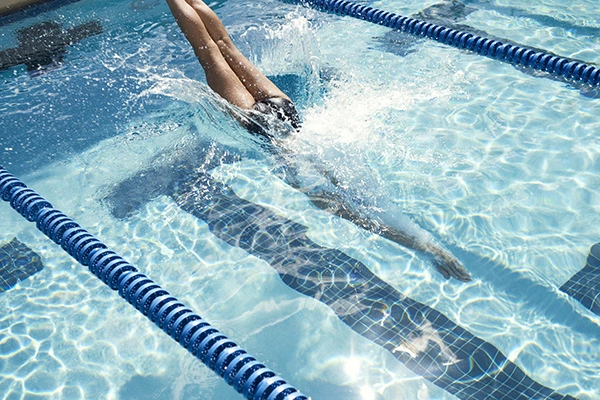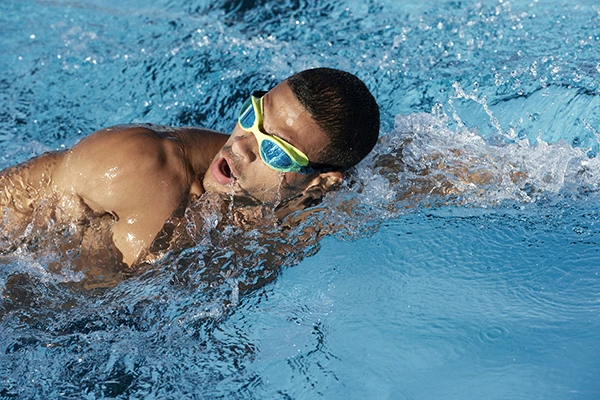Freestyle Arm Aches? It's Time to Regulate the Movements!
Freestyle is the swimming style that many beginners will choose. However, when many beginners swim freestyle, they often feel that their arms are sore and weak after swimming for a long time, and it is very difficult to stroke. Why can't they swim? Today we will teach you how to swim a better freestyle.
Let's learn about freestyle arm movements. First of all, enter the water lightly and act like touching something in front of you; then aim at the water to hold the water, that is, the palm of your hand should be backward, because if you want to move forward, you should paddle backward, rather than press the water down. When pushing the water, it is necessary to push it down to the bottom, that is, the position near the thigh. There is a requirement for acceleration to push the water. The elbow should be raised when moving the arm. When practicing, you can pretend to touch your ears with your hands, and the movements are similar; when holding water, your fingers should be close together.

By analyzing freestyle movements, it can be found that freestyle stroke mainly relies on shoulder movement, which is driven by back muscles to rotate, and shoulders then drive arms and wrists. The contraction of arm muscles is mainly to fix the hand shape and arm shape aiming at the water and is not used to generate the main forward power. The water pushing stage is mainly the instantaneous force of triceps brachii and wrists.
Many beginners feel arms sore and weak in freestyle. The root cause is that the stroke is not standardized. Swimming is a whole-body exercise, and almost all the big muscles drive the small muscles. It is impossible to push the whole body forward only by arm strength. In freestyle, the arm is pulled by the strength of the back, and the latissimus dorsi is the source of power. If you understand this, it will be much easier to learn.

At the same time, swimming strokes are also rhythmic and fast. When the hand just enters the water, it can stroke lightly to hold the water. When the arm is near the chest ribs, turn the wrist and stroke in the thigh direction. At the same time, with the help of hip rotation, shoulder rotation, and latissimus dorsi force, the arm is pulled quickly to push the water backward, thus generating huge power. This is an efficient freestyle stroke.
Finally, it should be noted that after a complete stroke, the body will move forward for a certain distance. At this time, we should find a good rhythm, making the next stroke in time, and don't let the body slide excessively, otherwise, the forward rhythm will be disrupted, and it will be much more difficult to strike again.
Let's learn about freestyle arm movements. First of all, enter the water lightly and act like touching something in front of you; then aim at the water to hold the water, that is, the palm of your hand should be backward, because if you want to move forward, you should paddle backward, rather than press the water down. When pushing the water, it is necessary to push it down to the bottom, that is, the position near the thigh. There is a requirement for acceleration to push the water. The elbow should be raised when moving the arm. When practicing, you can pretend to touch your ears with your hands, and the movements are similar; when holding water, your fingers should be close together.

By analyzing freestyle movements, it can be found that freestyle stroke mainly relies on shoulder movement, which is driven by back muscles to rotate, and shoulders then drive arms and wrists. The contraction of arm muscles is mainly to fix the hand shape and arm shape aiming at the water and is not used to generate the main forward power. The water pushing stage is mainly the instantaneous force of triceps brachii and wrists.
Many beginners feel arms sore and weak in freestyle. The root cause is that the stroke is not standardized. Swimming is a whole-body exercise, and almost all the big muscles drive the small muscles. It is impossible to push the whole body forward only by arm strength. In freestyle, the arm is pulled by the strength of the back, and the latissimus dorsi is the source of power. If you understand this, it will be much easier to learn.

At the same time, swimming strokes are also rhythmic and fast. When the hand just enters the water, it can stroke lightly to hold the water. When the arm is near the chest ribs, turn the wrist and stroke in the thigh direction. At the same time, with the help of hip rotation, shoulder rotation, and latissimus dorsi force, the arm is pulled quickly to push the water backward, thus generating huge power. This is an efficient freestyle stroke.
Finally, it should be noted that after a complete stroke, the body will move forward for a certain distance. At this time, we should find a good rhythm, making the next stroke in time, and don't let the body slide excessively, otherwise, the forward rhythm will be disrupted, and it will be much more difficult to strike again.